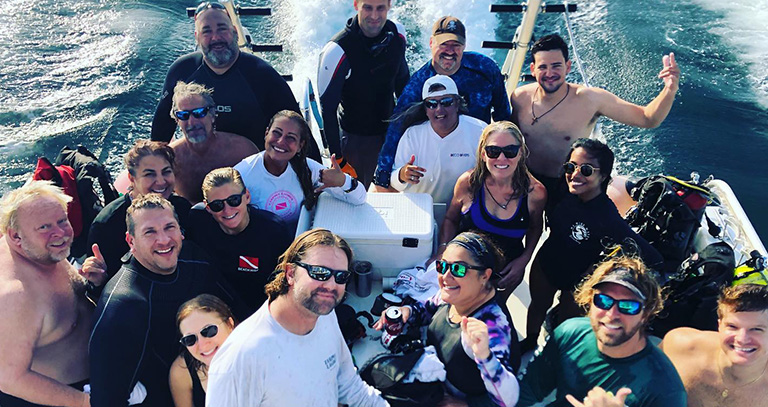Miami’s 2019 Lobster Season Guide

Happy Trailer Storage Welcomes Start of the 2019-20 Lobster Season in Miami
One of the most highly-anticipated events in Miami, lobster mini-season, officially begins at 12:01 a.m. on Wednesday, July 24 and ends at midnight the following day. This two-day event gives recreational fishermen the opportunity to get lobsters before the commercial season begins. The regular eight-month season starts shortly after on August 6th and runs through March 31, 2020.
Before you head out on the water, check out our tips below to ensure a safe and successful hunt!
SAFETY FIRST
There is always a risk associated with scuba diving, especially during mini-season. With thousands of recreational boaters on the water at one time, make sure to have your dive flag visible, bring a spotter, and keep your eyes and ears open. Also, if you are tempted to reach into a hole or under coral to grab a bug, don’t. You risk getting stuck or bitten by an unknown fish lurking below.
BRING THE CORRECT EQUIPMENT
There is nothing more frustrating during a dive than malfunctioning equipment. From a leaking mask to a broken regulator, make sure to avoid the hassle by having your gear tested and prepped for the season.
Common Lobstering Equipment
- Dive flag: All divers in Florida waters must display a dive flag and stay within 300-feet of open water.
- Lobster net and tail snare: Nets are used on sand flats, while snares are best for reefs.
- Tickle stick: A thin fiberglass rod about 24-inches long used to coax lobsters out of holes without harming the reef.
- Gloves: For the lobster, not the reef.
- Mesh bag: Used to hold your catch. Look for models that have a convenient way to attach to your weight belt or gear, and a locking enclosure. Be sure to put your name on all of your equipment.
- Lobster gauge: Every diver must carry a lobster gauge and must measure the lobster under-water before it’s placed in the game bag.
- Mask, fins, snorkel or dive gear
Be sure you are familiar with the rules of the lobster season before heading out on the water:
KNOW YOUR LIMITS
During the mini-season, recreational divers and snorkelers can take a maximum of 12 lobsters per person, per day in South Florida, except for Monroe County and Biscayne National Park where the limit is six per person, per day, and the Biscayne Bay/Card Sound Lobster Sanctuary where the taking of any lobster is prohibited. Possession limits are strictly enforced on and off the water. During the regular season, the maximum limit for all locations is six lobsters per person, per day.
SIZE MATTERS
It is important to remember that the body of the lobster, excluding the tail, should be larger than three inches, measured in the water. Have a measuring device on you at all times – it’s required by law. Be sure you are familiar with how to measure a lobster properly.
BUY A LICENSE OR GET FINED
Anyone taking or attempting to take a lobster must have a recreational saltwater fishing license and a spiny lobster permit to participate in the lobster season. These can easily be picked up at your local Publix Super Markets or online at GoOutdoorsFlorida.com.
KEEP THE LOBSTERS INTACT
Do not remove the tail. Lobsters must be kept intact from catch to arrival on shore.
WHERE TO LOBSTER IN SOUTH FLORIDA
While the Florida Keys draw the biggest crowds, there are a number of advantages to enjoying mini-season right here in your own backyard. One of the biggest perks is your overall catch. In the Keys and Monroe County, the limit per person, per day is six as opposed to South Florida which is 12. There are also plenty of lobster-heavy sites to choose from in Miami and the tri-county area. Also, since mini-season rules are looser, it’s legal to dive at night for lobster, so some dive operators offer a 24-hour charter schedule.
In Miami, you can start your hunt right from the beach. Legal-size lobster can be found within just 50-yards of the sands of South Beach, or you can join lobster charters to natural reefs, ledges, grass beds and man-made, state-approved rubble reefs.
In Broward and Palm Beach counties, the first reef line is an easy swim from shore and is home to plenty of bugs at the start of the season. If you’re looking for an adventure, there are numerous sites further offshore that local charter boats can take divers to. In Palm Beach, a popular spot for spiny lobster are the deep ledges off Jupiter Inlet. If you want to go a bit further, charters out of Palm Beach Inlet offer a selection of both deep ledges and shallow reef lines that hold plenty of big bugs for drift divers
Stay safe and enjoy lobster season!
